Joyce Biography: Joycean Memoir & Photography
- At May 29, 2022
- By Great Quail
- In Joyce
 0
0

Joyce Biography: Joycean Memoir & Photography
This page profiles Joyce-related memoirs and diaries. It also includes books of photography. The memoirs are listed in the order they fit into Joyce’s biography, not by the date they were written, recovered, or published. Clicking a cover image takes you to Amazon.com. When Brazen Head commentary is unavailable, the publisher’s summaries are usually reprinted. If any knowledgeable Joyce reader would like to review, summarize, or provide additional information for any of these “uncommented” books, please drop us a line! Additional Joycean biographies may be found by clicking the links below:
Joyce Biography
[Main Page | Biographical Sketch | Chronology | Joyce Biographies | Family & Associates | Memoirs & Photos | Letters | Dublin]
Joyce-Related Memoirs & Diaries
The Dublin Diary of Stanislaus Joyce
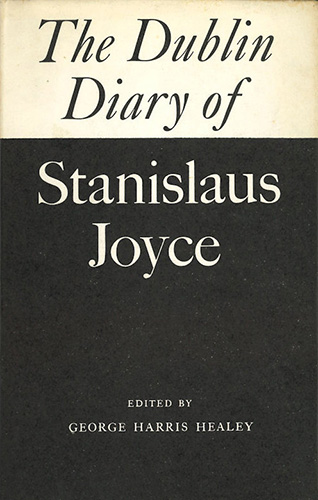
The Dublin Diary of Stanislaus Joyce
By Stanislaus Joyce. Edited by George Harris Healey
Cornell University Press/Faber and Faber, 1962
Current: Forgotten Books, 2018
Available online at: Internet Archive
The Complete Dublin Diary of Stanislaus Joyce
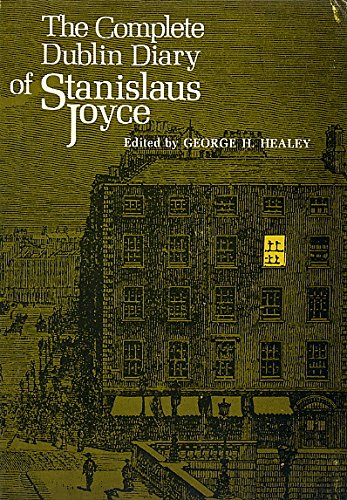
The Complete Dublin Diary of Stanislaus Joyce
By Stanislaus Joyce. Edited by George Harris Healey
Cornell University Press, 1971
Available online at: Internet Archive
Healey’s informative preface offers an excellent introduction to the book:
Maurice Daedalus, the brother in James Joyce’s Stephen Hero, keeps a diary. Mr. Duffy, the principal character of “A Painful Case,” in Dubliners, likewise keeps “a little sheaf of papers held together with a brass pin,” in which “a sentence was inscribed from time to time.” Both Maurice Daedalus and Mr. Duffy are derived from the author’s younger brother Stanislaus, and Stanislaus did indeed keep a diary, in which the sentences he inscribed from time to time often had to do with his brother. That sheaf of papers, still held together by the brass pin, has survived and is here published in full.
Though called a diary by Stanislaus and James, and hence by others who have mentioned it, the manuscript is rather a collection of descriptions, confessions, anecdotes, and comments. Some are dated, some are not. Some are placed in chronological sequence, some are not. The journal records events in the daily life and thoughts of the tormented young Dubliner who, though uncertain about many things, was utterly convinced even then that his brother was an extraordinary person whose quality the world would one day recognize and whose thoughts and actions were worth setting down. “The interest which I took in Jim’s life was the main interest I took in my own; my life is dull without him,” he writes in a separate note after James’s departure from Ireland. In recording incidents of his own life, then, Stanislaus includes a good deal about James’s, at a time when he probably knew his brother better than anyone else did. Since James Joyce conspicuously assumes his readers to be acquainted with minute details of his personal history, Stanislaus’ journal is often relevant to James’s writings. The diary begins in 1903, soon after the crisis of their mother’s death, and ends sometime in 1905, after James’s sailing for the Continent has left journal and journalist noticeably less lively. But James is never absent from the diary for long, and throughout much of it he and his doings, at one of the most interesting periods of his life, appear on almost every page. Although Stanislaus gives to no entry the date 16 June—he could hardly have predicted Bloomsday—he does mention in one place or other many of the persons who appear as characters in Ulysses, and many also who turn up in Dubliners, Stephen Hero, and A Portrait of the Artist as a Young Man. A large circle of relatives, friends, and acquaintances of the young Joyces are assembled here, Gogarty, Byrne, Cosgrave, the Sheehys, the Murrays, and many another, and also of course the Joyces themselves, of y St. Peter’s Terrace, Cabra.
In 1971 Dublin Diary was revised, expanded, and given a new cover. This version was published as The Complete Dublin Diary of Stanislaus Joyce. As Healey explains in his revised preface:
This edition gives the complete text of the manuscript. An earlier edition entitled The Dublin Diary of Stanislaus Joyce, published in 1962, omitted certain parts of the diary for a number of unrelated reasons. Some of the material then set aside would have embarrassed persons then living, some would have strained the tolerance of publishers and public, some was thought to hold only marginal interest because of having little to do with James Joyce. The passage of time has now removed or modified most of the solicitudes of a decade ago, and Stanislaus’ emergence as a person interesting in his own right has libcrated his diary from depending wholly on his brother for its interest. Everything now present in the diary, including about thirty-six pages of manuscript not printed in the first edition, appears here. Ellipses and dashes, where they occur, are transcribed from the source. A few errors in the earlier edition have been corrected, and, thanks in part to advances in Joyce scholarship during the interval, the explanatory notes have been revised and extended.
Unfortunately, both versions are out of print, and the 2018 “Forgotten Books” print-on-demand copy only contains the text of the original 1962 edition.
James Joyce Remembered
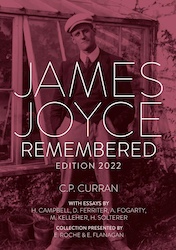
James Joyce Remembered
By C.P. Curran
First Edition: Oxford University Press, 1968
Second Edition: University College Dublin Press, 2022
Available online at: Internet Archive
Publisher’s Description: C.P. Curran first met James Joyce in a University College Dublin lecture hall in 1899, and the two quickly struck up an intense lifelong friendship. Curran was a model for the character Gabriel in Joyce’s “The Dead” and was also one of the first people to reject a piece of Joyce’s writing—the 1904 poem “The Holy Office,” which Curran, as editor of St. Stephen’s, lightheartedly deemed “an unholy thing.” Curran even is mentioned by name in Ulysses, where Stephen Dedalus recalls that he owes him ten guineas. In 1968, Curran summed up his views of the seminal Modernist author in James Joyce Remembered. This year—the centennial anniversary of Ulysses’ publication—University College Dublin Press is pleased to bring forth a new edition of this classic remembrance, edited by Curran’s granddaughter and featuring sparkling new essays from a host of Joyce scholars, literary critics, architects, and historians. This group of University College Dubliners takes a new look at Curran’s work, delving into the Curran-Laird collection at the James Joyce Library to offer a singular portrait of the author and his inventive cohort of friends. The world of Joyce and Curran opens up, revealing little-known writing and episodes in political activism, during the Irish wars that flared up again in 1922 as Ulysses first began circulating, and the struggles against fascism that came to engulf Joyce’s Paris. This highly illustrated tribute to a literary figurehead is perfect reading for Joyce neophytes, Bloomsday aficionados, and anyone interested in examining this watershed period of Irish history through an international lens.
Our Friend James Joyce

Our Friend James Joyce
By Mary and Padraic Colum
Doubleday & Company, 1958
Available online at: Internet Archive
The Irish poet and playwright Padraic Colum (1981-1972) first met James Joyce in Dublin in 1901, when both were becoming involved in the Abbey Theatre. In 1912, Padraic married Irish literary critic and editor Mary Catherine Gunning Maguire (1884-1957). The pair led an active life, moving around Europe and the United States, writing, lecturing, and contributing to various literary magazines. Although Joyce originally considered “Patrick What-do-you-Colm” a rival, Colum never tired of promoting Joyce’s work, and the two eventually became close friends. Colum helped negotiate the thorny publication of Dubliners, and supplied the introduction to the first American edition. In 1928, he wrote the preface to the first edition of Anna Livia Plurabelle, the episode from Work in Progress later incorporated into Finnegans Wake. In 1930 the Colums moved to Paris and deepened their relationship with the Joyces. Padraic helped the nearly-blind James transcribe Finnegans Wake, while Mary cared for Lucia during a bout of “hebephrenia.” The couple then relocated to New York City, where Padraic helped found the James Joyce Society in 1947, soon after succeeding John Slocum as the Society’s second president.
In 1953 Padraic Colum drafted a short memoir of his time with Joyce in Dublin; this soon became a larger project co-authored with Mary, who suggested a more ambitious narrative. Unfortunately, her death in 1957 left the book unfinished. Working from her notes, Padraic completed Our Friend James Joyce in 1958, the year before Richard Ellmann published his monumental James Joyce. Our Friend is divided into two sections, “Dublin” and “Paris,” and contains alternating reminiscences clearly labeled as “Padraic Colum” and “Mary M. Colum.” Padraic’s entries are better written, as he’s got a fine sense of humor and a flair for description; however, Mary’s are more informative, largely sticking to facts enlivened by the occasional frank opinion. Visitors interested in the history of Our Friend James Joyce are directed to James P. Sullivan’s “Padraic Colum’s James Joyce as a Young Man,” published in the James Joyce Quarterly.)
James Joyce and the Making of Ulysses

James Joyce and the Making of Ulysses
By Frank Budgen
First Edition: Grayson & Grayson, 1934
Most Current: Oxford University Press, 1989
Available online at: Internet Archive | University of Wisconsin-Madison
Frank Bugden (1882-1971) was an English painter who befriended James Joyce in Zurich. During the years 1918-1919, the two spent a great deal of time together, taking walks, drinking wine, and discussing their respective projects. Joyce used Bugden as a soundboard for his thinking about Ulysses, and Budgen painted several portraits of Joyce. The two maintained a warm correspondence even after the War, when Budgen returned to England and pursued a political career as a socialist. In 1934, Budgen published James Joyce and the Making of Ulysses.
One of the most interesting works of early Joyce scholarship, Budgen’s book offers an approachable walkthrough of each episode in Ulysses, detailing the relevant characters, actions, and conversations in plain language. In this way, The Making of Ulysses is the precursor to works like Harry Blamires’ Bloomsday Book and Patrick Hasting’s Guide to James Joyce’s Ulysses. What makes Budgen’s guide unique, of course, is his personal relationship with James Joyce himself. As Joyce’s trusted confidant, Budgen offers an unparalleled window into Joyce’s creative process. For instance, this passage excerpted from the chapter on “Proteus”:
You were going to do wonders, what? Missionary to Europe after fiery Columbanus. Fiacre and Scotus on their creepystools in Heaven spilt from their pintpots loudlatinlaughing: Euge! Euge! Pretending to speak broken English as you dragged your valise, porter threepence, across the slimy pier at Newhaven. Comment? Rich booty you brought back; Le Tutu, five tattered numbers of Pantalon Blanc et Culotte Rouge, a blue French telegram, curiosity to show:
‘Mother dying come home father.’
Joyce looked up and said:
“I haven’t let this young man off very lightly, have I? Many writers have written about themselves. I wonder if any one of them has been as candid as I have?”
While one may legitimately wonder about the accuracy of conversations recalled years after the fact, Budgen shows a genuine warmth and affection for his friend, and the image of Joyce that emerges from his reflections is remarkably consistent. Along with reminiscences about his time spent with Joyce, Budgen also offers insightful comments on Dubliners, Portrait, and Finnegans Wake, then known as “Work in Progress.” As befitting a book written by an artist, The Making of Ulysses features several illustrations. Sadly, Budgen’s memoir/guide has been out of print since 1989, but used copies remain plentiful, and a PDF is available through the University of Wisconsin-Madison.
Conversations with James Joyce
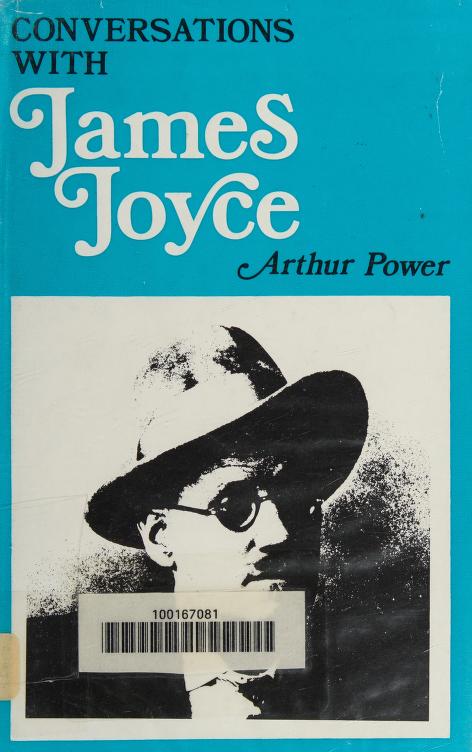
Conversations with James Joyce
By Arthur Power. Edited by Clive Hart
First Edition: Millington, 1974
Current: Dalkey Archive Press, 1987
Available online at: Internet Archive
Publisher’s Description: A memoir of James Joyce, one of the most important novelists of the twentieth century, never before published in North America. In the ordinary sense Joyce was not a conversationalist, writes Arthur Power, in Conversations with James Joyce. An aspiring painter and art critic, Power (of the famous whiskey family) struck up a strained, somewhat prickly friendship with the master of exile, silence, and cunning at the Bal Bullier in Paris, in the year of 1921. This volume is Power’s record of the two men’s encounters and conversations, whose subjects ranged from Irish literature to American politics, and from Assyrian monuments to the individual “odor of a country,” which, Joyce assured his wide-eyed interlocutor, was “the gauge of its civilization.” Here is a rare glimpse of the private James Joyce―to Power’s great surprise, not a brash bohemian, but a steadily working, sharp-tongued, elusive man. Arthur Power’s Conversations with James Joyce, edited by Clive Hart and originally published in 1974, is an important artifact relating Joyce’s thoughts and opinions on past writers as well as his contemporaries: Synge, Ibsen, Hardy, Turgenev, Tolstoy, Chekhov, Dostoevsky, Gide, Proust, Eliot, Tennyson, and Shakespeare.
James Joyce and Paul L. Léon: The Story of a Friendship
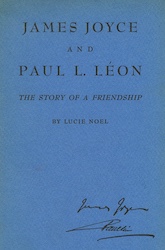
James Joyce and Paul L. Léon: The Story of a Friendship
By Lucie Noël
Gotham Book Mart, 1950
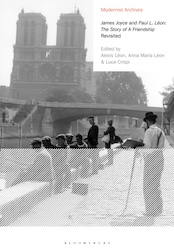
James Joyce and Paul Léon: The Story of a Friendship Revisited
By Lucie Noël; ed. Alexis Léon, Anna Marie Léon & Luca Crispi
Bloomsbury Academic, 2024
Publisher’s Description (2024): James Joyce spent the last decade of his life in Paris, struggling to finish his great final work Finnegans Wake amidst personal and financial hardship and just as Europe was being engulfed by the rising tide of fascism. Bringing together new archival discoveries and personal accounts, this book explores one of the central relationships of his final years: that with his friend, confidant and adviser Paul L. Léon. Providing first-hand accounts of Joyce’s Paris circle—which included Samuel Beckett and Vladimir Nabokov—the book makes available again the text of Lucie (Léon) Noël’s personal memoir of the relationship between her husband and the Irish writer (published as James Joyce and Paul L. Léon: The Story of Friendship in 1950), including his valiant rescue of Joyce’s Paris archives from occupying Nazi forces. The book also collects for the first time Léon’s clandestine letters to his wife from August to December 1941, chronicling his desperate state of body and mind while interned in Drancy, France’s main Nazi transit camp, and then in Compiègne, just before he was deported to Auschwitz-Birkenau. Joyce died suddenly on 13 January 1941 in Zurich and Léon was murdered by the Nazis on 4 April 1942 in Silesia. Annotated throughout with contextual commentary by Luca Crispi and Mary Gallagher, this is an essential resource for scholars of James Joyce and of the literary culture of Paris in the 1930s and first years of World War II in France.
Reflections on James Joyce: Stuart Gilbert’s Paris Journal
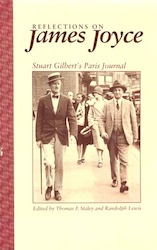
Reflections on James Joyce: Stuart Gilbert’s Paris Journal
By Stuart Gilbert. Edited by Thomas F. Staley and Randolph Lewis
University of Texas Press, 1993
Available online at: Internet Archive
Publisher’s Description: Stuart Gilbert’s friendship with James Joyce began in Paris in 1927 after Gilbert read several pages from a forthcoming French translation of Ulysses in the window of Sylvia Beach’s Shakespeare and Company book shop and went in to tell Beach that the translation was poorly done. She reported the encounter to Joyce, who subsequently sought out Gilbert. Their meeting began a literary collaboration and friendship that lasted until Joyce’s death in 1941. This journal is a chronicle of that remarkable and productive friendship. Stuart Gilbert records many amusing anecdotes and provocative opinions regarding Joyce’s social life, his relationship with his wife, Nora, and his compositional techniques for Finnegans Wake. Also included in the book are some of Joyce’s previously unpublished letters to Gilbert (also reproduced in photographs), numerous unpublished photographs, and a typically dyspeptic 1941 essay on Joyce, Paul Léon, and Herbert Gorman by Gilbert. The volume is fully annotated and contains an introduction by noted Joyce scholar Thomas F. Staley. These materials from the Stuart Gilbert Archive of the Harry Ransom Humanities Research Center at the University of Texas at Austin offer new perspectives on literary Paris of the 1920s and 1930s. They will be important for everyone interested in the modernist period.
Joyce-Related Photography
James Joyce in Paris: His Final Years
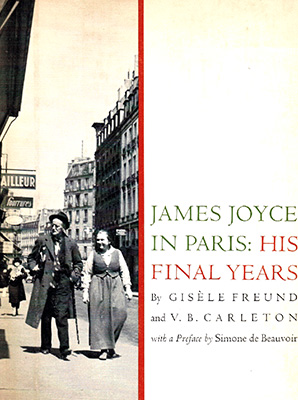
James Joyce In Paris: His Final Years
By Gisèle Freund & V.B. Carleton
Preface by Simone de Beauvoir
Harcourt, Brace & World, 1965
Available online at: Internet Archive
Three Days with Joyce

Three Days with Joyce
By Gisèle Freund
Preface by Richard Ellmann
Persea Books, 1985
Available online at: Internet Archive
Gisèle Freund (1908-2000) was a Berlin-born photographer who made her career in Paris. One of the most famous photographers of twentieth-century Europe, her name has been associated with nearly every important artistic and cultural movement from the Frankfurt School to the Bloomsbury Group to Modernism. In 1942 she fled Paris and moved to Buenos Aires, where she became intimate with Victoria Ocampo’s Sur group, which included Jorge Luis Borges. Later she moved to Mexico and photographed Diego Rivera and Frida Kahlo. In 1953 she returned to Paris, were she lived and worked until her death in 2000.
In 1938 Sylvia Beach and Adrienne Monnier suggested to Freund that she photograph James Joyce, who was about to unleash Finnegans Wake on the world. Freund remained with the Joyces for three days, capturing a series of candid photos of Joyce working, visiting Shakespeare and Company, relaxing with his family, and playing with his grandson Stephen. Sadly, Nora declined to be in the photos. Individual photographs were published separately here and there, but in 1965 Freund and the American-born Parisian journalist Verna B. Carelton published James Joyce in Paris: His Final Years, which included a preface by Simone de Beauvoir. A lovely book, it contained Freund’s Joyce photographs with numerous others she took of contemporary Paris, along with writers and notable figures like Virginia Woolf and T.S. Eliot. Many of the photos were accompanied by captions from Joyce’s writing.
In 1982, a significantly-reduced version of this book was published as Trois Jours Avec Joyce. In 1985 this was translated into English as Three Days with Joyce and given a new preface by the omnipresent Richard Ellmann. A fraction the length of James Joyce in Paris, the new book only collects Freund’s photos of Joyce and his family. It also lacks the lovely captions. (Who knows, maybe Stephen wouldn’t give them the rights?) Furthermore, the paperback version of Three Days with Joyce omits the color photograph on the cover and frontispiece, and excises Freund’s comment about that famous portrait: “Nor did I show Joyce the color portrait in which he is seen head-on. I found it too revealing and tragic and I did not wish to upset him. It appears here for the first time in color.”
Anyway, since both books are now out-of-print, the 1965 collection remains more desirable, and is usually only a few dollars higher than the abbreviated version.
Note: Because the 1985 Publisher’s Weekly review of Three Days with Joyce is prominently featured on Amazon, I am reprinting it here with a warning. First of all, the paperback version does not contain the color photograph. But more importantly, the PW reviewer curiously mistakes Giorgio’s wife Helen for Nora Joyce, who does not appear in Freund’s photos. Nor does Joyce’s daughter Lucia, for that matter, who was “relaxing” in a sanatorium at the time. Maybe you guys want to actually read the captions? Anyway, caveat emptor.
Publishers Weekly: Joyce’s lauded biographer, Richard Ellmann, professor at Oxford, provides a moving, informative introduction to Freund’s landmark book. The photographer’s text and pictures create a rare feeling of intimacy with the author of Ulysses and Finnegans Wake when he was living in Paris during the late 1930s. Joyce is seen conferring with his family’s best friends, Eugene and Marta Jolas (they published sections of Finnegans Wake in their review, transition); with Sylvia Beach and Adrienne Monnier (who published Ulysses) et al. But the most eloquent photos epitomize Joyce’s “iron affection” for his wife Nora, his daughter, his son and daughter-in-law and their child. Relaxing in their company, the great author displays the Irish wit usually hidden by his shyness or insecurity. In the closeups that include a striking color shot, one sees the artist as an older man, marked by worry over reactions to his innovative novels, by heartbreak over the mental illness of his beloved young daughter Lucia, a myriad of emotions behind the familiar, peering eyes.
Joyce Images
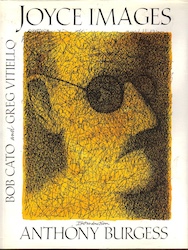
Joyce Images
By Bob Cato and Greg Vitiello
W.W. Norton, 1994
A “coffee-table” book, this work is a collection of photographs, drawings and cartoons about James, Nora, and the Joyce family. Comprehensive and neatly organized, the book has an introduction by Anthony Burgess—one of the last things he wrote before he died. Many of the photos are quite striking and rarely seen, including one of Ezra Pound visiting Joyce’s grave, and more than a few have never before been published. Highly recommended, and easily available through a used book search.
Joycean Memoirs
The Necessary Fiction: Life with James Joyce’s Ulysses

The Necessary Fiction: Life with James Joyce’s Ulysses
By Michael Groden
First Edition: Edward Everett Root, 2019
Second Revised & Expanded Edition: Edward Everett Root, 2021
Michael Groden (1947-2021) was born in Buffalo, earned his PhD at Princeton, and eventually settled at the University of Western Ontario. One of the foremost Joyce scholars of his generation, Groden was obsessed with Ulysses all his life, and was responsible for many of the hyper-textual studies of Ulysses that brought Joyce into the computer age during the turn of the century. He has written many books about Joyce and Joyce studies, but his final work was a personal memoir of his time as a Joycean.
Publisher’s Description: This unusual book is a fascinating work of personal criticism or “biblio-memoir” which will appeal to all interested in James Joyce’s work, and, more widely, to those interested in responses to great art. It focusses on the life-long appeal of a particular work of art on a single individual who has been a leading Joyce scholar for 40 years. Professor Groden has taught Ulysses to undergraduates, to graduate students, and to adults outside of universities in a long and distinguished career. He is the author of two often-cited scholarly books on Joyce’s novel, and he has overseen the 63-volume facsimile reproduction of his manuscripts.
Groden says: “I’ve often been asked why I’ve devoted so much of my life to Joyce’s novel. The Necessary Fiction tries to answer that question. I wrote the book partly with seasoned readers and scholars of Ulysses in mind, but I aimed it especially at readers who desire to read, have attempted to read, or have even succeeded in reading Joyce’s novel and who will welcome an accessible, very personal introduction to it as well as a case for reading or rereading it. A neologism that has been applied to my work—‘autobloomography’—captures what I am trying to do in The Necessary Fiction. The first half of the book considers various possible reasons for Ulysses’ powerful impact on me when I read it as a 19-year-old undergraduate at Dartmouth College and later worked on Joyce’s manuscripts for his novel as a graduate student at Princeton University. This section deals with each reason in relation to a significant person in my early life. The second half discusses Ulysses’ continuing fascination for me in my professional adult life as a university professor and Joyce scholar. Throughout the book, I’ve interspersed accounts of my life with Ulysses with analyses of the novel itself.”
Ulysses: A Reader’s Odyssey

Ulysses: A Reader’s Odyssey
By Daniel Mulhall
New Island Books, 2022
Written by the Irish Ambassador to the United States, Ulysses: A Reader’s Odyssey is a memoir of a lifetime spent in the company of Ulysses. The book was published in celebration of the Ulysses centennial, and contains many delightful observations, even if it suffers from an accessional lack of focus. The Brazen Head published a full review of Ulysses: A Reader’s Odyssey in July 2022.
Publisher’s Description: Marking the centenary of Ireland’s—and possibly the world’s—most famous novel, this joyful introductory guide opens up Ulysses to a whole new readership, offering insight into the literary, historical and cultural elements at play in James Joyce’s masterwork. Both eloquent and erudite, this book is an initiation into the wonders of Joyce’s writing and of the world that inspired it, written by Daniel Mulhall, Ireland’s ambassador to the United States and an advocate for Irish literature around the world. One hundred years on from that novel’s first publication, Ulysses: A Reader’s Odyssey takes us on a journey through one of the twentieth century’s greatest works of fiction. Exploring the eighteen chapters of the novel and using the famous structuring principle of Homer’s Odyssey as our guide, Daniel Mulhall releases Ulysses from its reputation of impenetrability, and shows us the pleasure it can offer us as readers.
Joyce Biography
[Main Page | Biographical Sketch | Chronology | Joyce Biographies | Family & Associates | Memoirs & Photos | Letters | Dublin]
Author: Allen B. Ruch
Last Modified: 15 June 2024
Main Joyce Page: The Brazen Head
Contact: quail(at)shipwrecklibrary(dot)com
